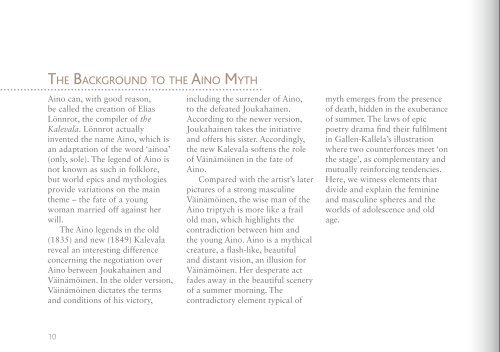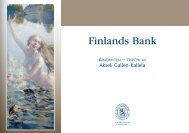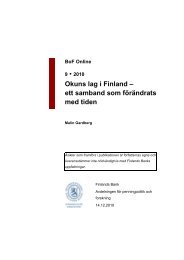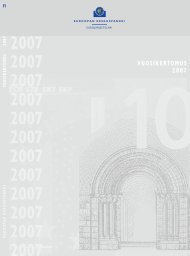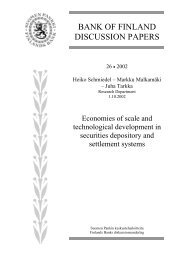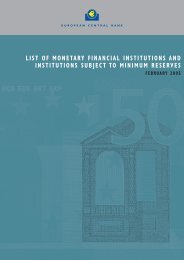Akseli Gallen-Kallela - Suomen Pankki
Akseli Gallen-Kallela - Suomen Pankki
Akseli Gallen-Kallela - Suomen Pankki
You also want an ePaper? Increase the reach of your titles
YUMPU automatically turns print PDFs into web optimized ePapers that Google loves.
The Background to the Aino Myth<br />
Aino can, with good reason,<br />
be called the creation of Elias<br />
Lönnrot, the compiler of the<br />
Kalevala. Lönnrot actually<br />
invented the name Aino, which is<br />
an adaptation of the word ‘ainoa’<br />
(only, sole). The legend of Aino is<br />
not known as such in folklore,<br />
but world epics and mythologies<br />
provide variations on the main<br />
theme – the fate of a young<br />
woman married off against her<br />
will.<br />
The Aino legends in the old<br />
(1835) and new (1849) Kalevala<br />
reveal an interesting difference<br />
concerning the negotiation over<br />
Aino between Joukahainen and<br />
Väinämöinen. In the older version,<br />
Väinämöinen dictates the terms<br />
and conditions of his victory,<br />
including the surrender of Aino,<br />
to the defeated Joukahainen.<br />
According to the newer version,<br />
Joukahainen takes the initiative<br />
and offers his sister. Accordingly,<br />
the new Kalevala softens the role<br />
of Väinämöinen in the fate of<br />
Aino.<br />
Compared with the artist’s later<br />
pictures of a strong masculine<br />
Väinämöinen, the wise man of the<br />
Aino triptych is more like a frail<br />
old man, which highlights the<br />
contradiction between him and<br />
the young Aino. Aino is a mythical<br />
creature, a flash-like, beautiful<br />
and distant vision, an illusion for<br />
Väinämöinen. Her desperate act<br />
fades away in the beautiful scenery<br />
of a summer morning. The<br />
contradictory element typical of<br />
myth emerges from the presence<br />
of death, hidden in the exuberance<br />
of summer. The laws of epic<br />
poetry drama find their fulfilment<br />
in <strong>Gallen</strong>-<strong>Kallela</strong>’s illustration<br />
where two counterforces meet ‘on<br />
the stage’, as complementary and<br />
mutually reinforcing tendencies.<br />
Here, we witness elements that<br />
divide and explain the feminine<br />
and masculine spheres and the<br />
worlds of adolescence and old<br />
age.<br />
10


